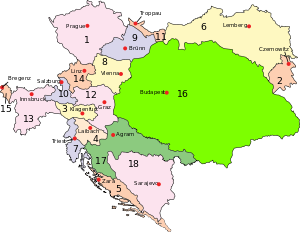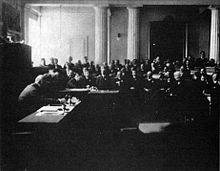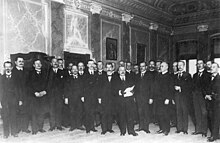National Council Of Slovenes, Croats And Serbs
On 19 October 1918, the National Council declared itself the supreme body of the State of Slovenes, Croats and Serbs. This position was upheld by the Croatian Sabor meeting on 29 October to sever ties between Croatia-Slavonia, Dalmatia and the city of Rijeka on one hand and the Kingdom of Hungary and Austria-Hungary on the other. The National Council took part in negotiating the Geneva Declaration in early November as an agreement on unification with the Kingdom of Serbia in a confederal state. The declaration was quickly repudiated. Instead, the National Council sent a delegation to Serbia to request speedy unification, as it was facing pressure from widespread violence and disorder in the countryside and the advancing Italian Army. The delegation ignored the instructions provided by the National Council and asked for unification without any specific conditions. By early December 1918, the National Council declared the bulk of its work completed.
Background

Cisleithania (Empire of Austria): 1. Bohemia, 2. Bukovina, 3. Carinthia, 4. Carniola, 5. Dalmatia, 6. Galicia, 7. Küstenland, 8. Lower Austria, 9. Moravia, 10. Salzburg, 11. Silesia, 12. Styria, 13. Tyrol, 14. Upper Austria, 15. Vorarlberg;
Transleithania (Kingdom of Hungary): 16. Hungary proper 17. Croatia-Slavonia;
Austro-Hungarian condominium 18. Bosnia and Herzegovina
During World War I, several proposals advocated the political consolidation of the South Slavs living in Austria-Hungary.
Niš Declaration
The Kingdom of Serbia—a country independent country from Austria-Hungary—considered the war an opportunity for territorial expansion beyond the Serb-inhabited areas of the Balkans. A committee tasked with determining the country's war aims produced a programme to establish a Yugoslav state through the addition of Croatia-Slavonia, the Slovene lands, Vojvodina, Bosnia and Herzegovina, and Dalmatia, echoing Serbian Foreign Minister Ilija Garašanin's 1844 Načertanije treatise anticipating the collapse of the Ottoman Empire, which called for the unification of all Serbs to pre-empt Russian or Austrian expansion into the Balkans. In its subsequent Niš Declaration, the Serbian government declared its war aims to liberate and unify "three tribes of one people": the Serbs, Croats, and Slovenes according to Yugoslavism.
Zagreb Resolution
Trialism in Austria-Hungary would have established a South Slavic entity in addition to the existing Cisleithanian and Transleithanian parts introduced by the Austro-Hungarian Compromise of 1867. South Slavic members of the Imperial Council organised as the Yugoslav Club and issued the trialist May Declaration.
In 1918, the Yugoslav Club tried to bring together the political parties representing the South Slavs in Austria-Hungary in favour of the "national concentration" of Slovenes, Croats, and Serbs in a common state. However, the club did not elaborate on the method or desired outcomes of such unification. A conference in Zagreb in May 1918 was attended by 43 opposition politicians from Croatia-Slavonia, politicians affiliated with the Zagreb-based Catholic daily Novine, members of the Social Democratic Party of Croatia and Slavonia, the Slovene People's Party, the National Progressive Party, as well as several politicians from Bosnia and Herzegovina, Dalmatia, Istria, and Međimurje. Croatia-Slavonia's ruling Croat-Serb Coalition and opposition Croatian People's Peasant Party were invited, but did not attend except for a number of dissidents. Attendees agreed to the Zagreb Resolution for political unification of the Croats, Slovenes, and Serbs living in Austria-Hungary.
Role
State of Slovenes, Croats and Serbs

To fulfill the Zagreb Resolution and work towards the political independence and unity of the South Slavs, another conference was held in Zagreb on 5-8 October 1918 and the National Council of Slovenes, Croats and Serbs was announced. Emperor Charles I tried to stave off the dissolution of Austria-Hungary by announcing a trialist reform of the empire on 16 October, but it came too late for the National Council. Instead, on 19 October, the National Council proclaimed itself the central organ of the new State of Slovenes, Croats and Serbs encompassing the Slovene lands, Croatia-Slavonia, Dalmatia, and Bosnia and Herzegovina.
On 29 October, the Croatian Sabor (nominally governing Croatia-Slavonia) severed its ties to Austria-Hungary and the Kingdom of Hungary and nullified the Croatian–Hungarian Settlement, declaring Croatia-Slavonia, together with Dalmatia and the city of Rijeka (previously organised as the Corpus separatum), a state independent of Austria and Hungary. The Croatian Sabor recognised the National Council as the supreme authority over the new state.
Unification with Serbia

The National Council and its representatives took part in the political unification of South Slavs through the establishment of the Kingdom of Serbs, Croats and Slovenes in late 1918. Due to lack of diplomatic experience, the council authorised the Yugoslav Committee, an ad-hoc group of politicians and activists, to speak on its behalf in international relations. After the Serbian government led by Nikola Pašić recognised the National Council as the legitimate representative of South Slavs living in the territory of Austria-Hungary, a National Council delegation, led by its president Anton Korošec, took part (jointly with the Yugoslav Committee and Serbian parliamentary opposition) in negotiations with Pašić, and signing of the Geneva Declaration on 9 November to quickly unite the State of Slovenes, Croats and Serbs with Serbia in a confederal state. Days later the declaration was repudiated by the Serbian government and the National Council's Croatian Serb vice-president, Svetozar Pribićević. Pribićević said the delegation was not authorised to conclude such an agreement.
The urgency of unification increased as security deteriorated in the countryside because of the Green Cadres, and the Italian Army advanced following the collapse of Austria-Hungary and the Armistice of Villa Giusti. By 17 November, Italian forces captured Rijeka and were advancing through Carniola, reaching the vicinity of Ljubljana—with the aim of enforcing the Treaty of London which promised Italy territorial gains in return for going to war against Austria-Hungary. In response, the National Council appealed to Serbia seeking protection against Italy. On 24 November, the National Council designated a delegation to contact the governments of Serbia and the Kingdom of Montenegro as well as other political parties in the two countries. The envoys travelled to Serbia's capital, Belgrade on 1 December where they met with Prince Regent Alexander of Serbia. At the meeting, the delegation of the National Council ignored their instructions to impose conditions on unification. Alexander proclaimed unification of the Kingdom of Serbs, Croats and Slovenes that day.
On 3 December, the delegation of the National Council declared the core work of the council completed, although stating it would continue administrative tasks for a while. The council disbanded its non-central bodies, but continued its administrative work in Zagreb until at least January 1919. The National Council decided to nominate all its members to the Temporary National Representation as the legislative body of the new state. However, the list of its representatives was drawn up by National Council member and new government minister Albert Kramer on authorisation by the regent but without input from the relevant political parties.
Zagreb protest
Shortly after proclamation of the Kingdom of Serbs, Croats and Slovenes, there was a protest of soldiers in Zagreb suppressed by forces organised and led by the National Council. In the aftermath of the events, the National Council disbanded the Zagreb-based 25th Regiment of the Royal Croatian Home Guard and the 53rd Regiment of the former Austro-Hungarian Common Army of the on the evening of 5 December. Furthermore, the council cited the clash and the Lipošćak affair as grounds to restrict the inclusion of Croatian officers who previously served in the Austro-Hungarian armed forces in army of the new unified state as unreliable.
Members

According to the Rules of the National Council, the body consisted of 95 voting members drawn from political parties and other organisations. In practice, the National Council had fewer members. The National Council originally intended to include 18 representatives from the regions of Međimurje, Baranya, Bačka, Banat, and Prekmurje, but those seats were left largely vacant. The members were meant to be territorially diverse, to ensure proportional representation of various territories of Austria-Hungary inhabited by South Slavs. The quorum required for valid decision making by a plenary session of the National Council was one-third of the voting members. The plenum was expected to adopt its decisions by majority of two-thirds of the members present.
The plenum was required to elect up to 30 members of the National Council's central committee (and their deputies) among themselves, and two-thirds majority of the central committee had the possibility of co-option of another ten members. The central committee required a quorum of more than half of its members. It was to make decisions by two-thirds majority as well, i.e. decisions could be made by 13 members in case of the minimum quorum meeting. The central committee was to convene the plenum once every three months or if requested to do so by 15 members of the National Council. The presidency of the National Council and its central committee consisted of president Korošec, vice-presidents Pribićević and Ante Pavelić. The presidency also included three secretaries: Mate Drinković, Srđan Budisavljević, and Ivan Lorković. The central committee turned over the executive powers to the presidency, deeming it the government of the National Council on 28 October 1918.
Members of the Imperial Council, Croatian Sabor, and diets of Bosnia and Herzegovina, Istria, and Dalmatia, and members of provinical legislatures of Carniola, Styria, Carinthia, and Gorizia and Gradisca not appointed to the National Council as its voting members were allowed to attend its meetings as observers. All observers were required to comply with the Rules of the National Council.
References
- ^ Headlam 1911, pp. 2–39.
- ^ Pavlowitch 2003, p. 32.
- ^ Pavlowitch 2003, p. 29.
- ^ Ramet 2006, p. 37.
- ^ Ramet 2006, p. 40.
- ^ Lampe 2000, pp. 102–103.
- ^ Matijević 2008, pp. 44–45.
- ^ Boban 1993, p. 187.
- ^ Matijević 2008, pp. 43–44.
- ^ Boban 1993, pp. 187–189.
- ^ Ramet 2006, pp. 42–43.
- ^ Boban 1993, pp. 191–192.
- ^ Boban 1993, p. 193.
- ^ Matijević 2008, p. 50.
- ^ Boban 1993, p. 195.
- ^ Banac 1984, pp. 134–135.
- ^ Pavlowitch 2014, p. 223.
- ^ Ramet 2006, pp. 43.
- ^ Boban 1993, pp. 196–198.
- ^ Matijević 2008, p. 66.
- ^ Štambuk-Škalić & Matijević 2008, p. 596.
- ^ Ramet 2006, pp. 46.
- ^ Ramet 2006, pp. 49.
- ^ Newman 2015, p. 132.
- ^ Zorko 2003, p. 900.
- ^ Boban 1993, pp. 188–189.
- ^ Štambuk-Škalić & Matijević 2008, pp. 86–89.
- ^ Štambuk-Škalić & Matijević 2008, pp. 73–75.
- ^ Štambuk-Škalić & Matijević 2008, p. 92.
- ^ Šišić 1920, pp. 171–174.
- ^ Štambuk-Škalić & Matijević 2008, pp. 89–92.
Sources
- Banac, Ivo (1984). The National Question in Yugoslavia: Origins, History, Politics. Ithaca, New York: Cornell University Press. ISBN 0-8014-1675-2.
- Boban, Ljubo (1993). "Kada je i kako nastala Država Slovenaca, Hrvata i Srba" [When and How Did the State of Slovenes, Croats, And Serbs Come into Existence]. Journal of the Institute of Croatian History (in Croatian). 26 (1). Zagreb: Croatian Institute of History: 187–198. ISSN 0353-295X.
- Headlam, James Wycliffe (1911). . In Chisholm, Hugh (ed.). Encyclopædia Britannica. Vol. 3 (11th ed.). Cambridge University Press.
- Lampe, John R. (2000). Yugoslavia as History: Twice There Was a Country (2nd ed.). Cambridge: Cambridge University Press. ISBN 0-521-77357-1.
- Matijević, Zlatko (2008). "Narodno vijeće Slovenaca, Hrvata i Srba u Zagrebu: Osnutak, djelovanje i nestanak (1918/1919)" [National Council of Slovenes, Croats and Serbs in Zagreb: Founding, Actions and Disappearance (1918/1919)]. Fontes: Izvori Za Hrvatsku Povijest (in Croatian). 14 (1). Zagreb: Croatian State Archives: 35–66. ISSN 1330-6804.
- Newman, John Paul (2015). Yugoslavia in the Shadow of War: Veterans and the Limits of State Building, 1903–1945. Cambridge: Cambridge University Press. ISBN 9781107070769.
- Pavlowitch, Kosta St. (2003). "The First World War and Unification of Yugoslavia". In Djokic, Dejan (ed.). Yugoslavism: Histories of a Failed Idea, 1918–1992. London: C. Hurst & Co. pp. 27–41. ISBN 1-85065-663-0.
- Pavlowitch, Stevan K. (2014). A History of the Balkans 1804-1945. Abingdon-on-Thames: Routledge. ISBN 9781317900177.
- Ramet, Sabrina P. (2006). The Three Yugoslavias: State-Building and Legitimation, 1918–2005. Bloomington: Indiana University Press. ISBN 978-0-253-34656-8.
- Šišić, Ferdo (1920). Dokumenti o postanku Kraljevine Srba, Hrvata i Slovenaca 1914–1919. Sabrao ih F. Šišić [Documents on Genesis of the Kingdom of Serbs, Croats and Slovenes 1914–1919; Collected by F. Šišić] (in Croatian). Zagreb: Matica hrvatska. OCLC 504490993.
- Štambuk-Škalić, Marina; Matijević, Zlatko, eds. (2008). "Narodno vijeće Slovenaca, Hrvata i Srba u Zagrebu 1918–1919. (izabrani dokumenti)" [National Council of Slovenes, Croats and Serbs in Zagreb 1918–1919 (Selected Documents)]. Fontes: Izvori Za Hrvatsku Povijest (in Croatian). 14 (1). Zagreb: Croatian State Archives: 71–596. ISSN 1330-6804.
- Zorko, Tomislav (2003). "Afera Lipošćak" [The Lipošćak Affair]. Časopis za suvremenu povijest (in Croatian). 35 (3). Zagreb: Croatian Institute of History: 887–902. ISSN 0590-9597.